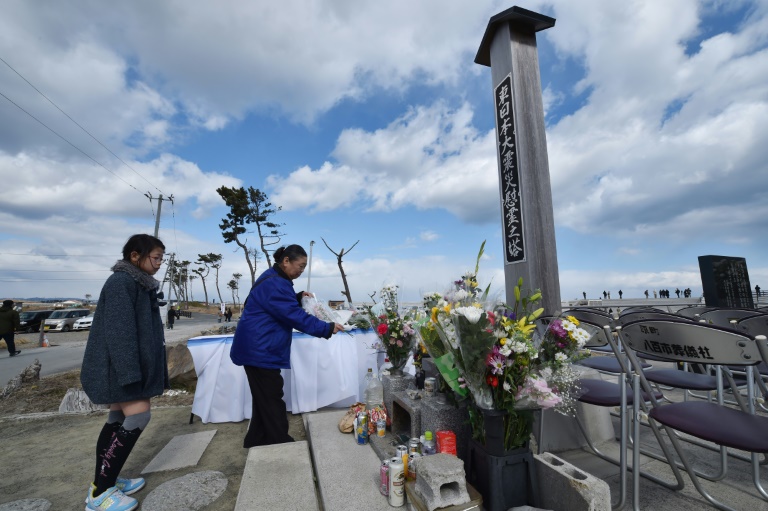
The unit 3 reactor building at Fukushima after the 2011 disaster © TEPCO/AFP / TEPCO
Tokyo, Japan, Mar 11 – Japan paused Saturday to mark six years since a deadly earthquake, tsunami and nuclear disaster devastated a wide swathe of its northeastern coast as more than 100,000 people remain unable or unwilling to return home.
The magnitude 9.0 quake, which struck under the Pacific Ocean on March 11, 2011, and the tsunami it spawned left about 18,500 people dead or missing.
The massive flow of water overwhelmed cooling systems at the Fukushima Daiichi power plant, causing meltdowns in three reactors in the worst nuclear disaster since Chernobyl in 1986.
The quake and tsunami caused extensive damage to homes and property while radiation spread over a wide area, with more than 450,000 people evacuating in the immediate aftermath.
More than 123,000 remain displaced, the majority from Fukushima prefecture due to high radiation. Some may never be able to go home.
At a national ceremony in Tokyo, Prime Minister Shinzo Abe and other participants bowed their heads in silent prayer at 2:46 pm (0546 GMT) — the exact moment the quake struck — as did many residents across the affected region.
“When I think of the despair of those who lost beloved members of their families and friends in the disaster, I am overwhelmed even now with deep sorrow,” Abe, dressed in formal mourning attire, told the gathering.

The Fukushima nuclear disaster © AFP / AFP
Japan’s ageing Emperor Akihito and Empress Michiko did not attend this year, but were represented by their son Prince Akishino and his wife Princess Kiko.
“My heart aches deeply,” Akishino said.
All attendees went to the stage to lay white flowers — a symbol of mourning — on a long white table. A live orchestra played melancholic classical music.
Separately, hundreds of police and firefighters combed beaches along the Fukushima coast, as they do on the 11th of each month, in a search for remains or other evidence of people still unaccounted for.
Many people gathered on beaches and other locations to pray, while some threw flowers into the ocean in remembrance of loved onces.
– ‘Learn from Fukushima!’
“The sea is so quiet today,” an elderly woman in the coastal town of Soma said on public broadcaster NHK. “Why did it become so rough and send up such big waves on that day?”

People offer a silent prayer to mark six years since a deadly earthquake, tsunami and nuclear disaster devastated Japan’s northeastern coast © AFP / KAZUHIRO NOGI
In Natori, one of the hardest-hit towns in Miyagi prefecture, some 100 people, mainly parents and classmates of deceased children, launched dove-shaped balloons attached with messages.
“You will forever live in our memories,” read one.
The latest National Police Agency figures show that the total of dead or missing from the earthquake and tsunami stood at 18,446 people.
Also, more than 3,500 deaths from causes such as illness and suicide have been linked to the aftermath, according to government figures.
While no deaths have been attributed to radiation exposure, some evacuees are concerned the government is moving too fast to deem closed off areas safe to inhabit.
“We fled solely to protect our children and grandchildren from radiation,” said Miyako Kumamoto, who criticised authorities for failing to help evacuees.
“I cannot accept this or understand why we have to be in this predicament” she told a press conference ahead of the anniversary.
Government evacuation orders for some 70 percent of the originally closed off areas will be lifted by April 1, except for certain towns near the battered facility, and authorities are encouraging evacuees to return.

A family offers flowers for victims of the 2011 quake-tsunami disaster at a cenotaph on the sea wall near Sendai, Miyagi prefecture © AFP / KAZUHIRO NOGI
Tokyo Electric Power Co (TEPCO), the plant operator, and the government are facing a four-decade task of cleaning up and decommissioning the facility.
In the evening, several hundred demonstrators gathered near Abe’s office and in front of parliament to denounce government policy to restart nuclear reactors around the country shuttered after the disaster.
“Learn from Fukushima!” and “Fukushima is angry!” read protest banners.
About The Author









































